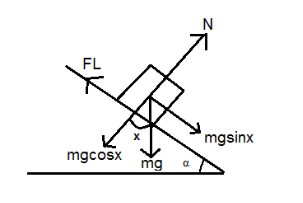
Define angle of repose. Prove that the coefficient of static friction is ‘tangent’ of the repose.
Answer
511.4k+ views
Hint: -Angle of repose is the minimum angle that an inclined plane makes with the horizontal plane when a body placed on it just begins to slide down. For the second part, you need to first make the free body diagram and mark the angle of repose and forces that will be acting on the block. This includes limiting friction, ${f_L}$, Normal force $N$, and the weight of the block $mg$. After equating all these forces in the form of an equation, use the formula for limiting friction and compare all the equations.
Formula used:
Limiting Friction, ${f_L} = \mu N$ where μ is the coefficient of friction, and $N$ is the normal force acting on the block.
Step-by-step solution:

Make the diagram of the block as shown. $mg$ is the weight of the block acting vertically downward, $N$ is the normal force acting perpendicular to the diagonal surface of ramp, ${f_L}$ is the limiting friction acting in the opposite direction of motion of block along the diagonal surface of the ramp, $\alpha $ is the angle of repose, $mg\cos x$ and $mg\sin x$ are the respective components of force $mg$.
Now, we know that angle $\alpha $ will be equal to the angle $x$. Therefore,
$mg\cos x$ = $mg\cos \alpha $
$mg\sin x$ = $mg\sin \alpha $.
⇒ $N$ = $mg\cos \alpha $ (net force on a static object = 0) ------${\text{equation(1)}}$
Also, ${f_L}$ = $mg\sin \alpha $ (net force on a static object = 0)
We know that ${f_L} = \mu N$
Substituting the values of $N$ and ${f_L}$ in the above equation, we get, $mg\sin \alpha $ = $\mu N$
⇒ $mg\sin \alpha $ = \[\mu \] × $mg\cos \alpha $ (using ${\text{equation(1)}}$)
On simplifying, we get,
$\sin \alpha $ = \[\mu \] × $\cos \alpha $ ($mg$ gets canceled)
⇒ $\dfrac{{\sin \alpha }}{{\cos \alpha }} = \mu $ ⇒ $\tan \alpha = \mu $
Hence Proved.
Note: Make a free body diagram of the block to make calculations and force markings easier. It is important to mark the forces in proper directions in the free body diagram to make all our calculations correct otherwise the complete solution may go wrong.
Formula used:
Limiting Friction, ${f_L} = \mu N$ where μ is the coefficient of friction, and $N$ is the normal force acting on the block.
Step-by-step solution:

Make the diagram of the block as shown. $mg$ is the weight of the block acting vertically downward, $N$ is the normal force acting perpendicular to the diagonal surface of ramp, ${f_L}$ is the limiting friction acting in the opposite direction of motion of block along the diagonal surface of the ramp, $\alpha $ is the angle of repose, $mg\cos x$ and $mg\sin x$ are the respective components of force $mg$.
Now, we know that angle $\alpha $ will be equal to the angle $x$. Therefore,
$mg\cos x$ = $mg\cos \alpha $
$mg\sin x$ = $mg\sin \alpha $.
⇒ $N$ = $mg\cos \alpha $ (net force on a static object = 0) ------${\text{equation(1)}}$
Also, ${f_L}$ = $mg\sin \alpha $ (net force on a static object = 0)
We know that ${f_L} = \mu N$
Substituting the values of $N$ and ${f_L}$ in the above equation, we get, $mg\sin \alpha $ = $\mu N$
⇒ $mg\sin \alpha $ = \[\mu \] × $mg\cos \alpha $ (using ${\text{equation(1)}}$)
On simplifying, we get,
$\sin \alpha $ = \[\mu \] × $\cos \alpha $ ($mg$ gets canceled)
⇒ $\dfrac{{\sin \alpha }}{{\cos \alpha }} = \mu $ ⇒ $\tan \alpha = \mu $
Hence Proved.
Note: Make a free body diagram of the block to make calculations and force markings easier. It is important to mark the forces in proper directions in the free body diagram to make all our calculations correct otherwise the complete solution may go wrong.
Recently Updated Pages
Why are manures considered better than fertilizers class 11 biology CBSE

Find the coordinates of the midpoint of the line segment class 11 maths CBSE

Distinguish between static friction limiting friction class 11 physics CBSE

The Chairman of the constituent Assembly was A Jawaharlal class 11 social science CBSE

The first National Commission on Labour NCL submitted class 11 social science CBSE

Number of all subshell of n + l 7 is A 4 B 5 C 6 D class 11 chemistry CBSE

Trending doubts
What is meant by exothermic and endothermic reactions class 11 chemistry CBSE

10 examples of friction in our daily life

One Metric ton is equal to kg A 10000 B 1000 C 100 class 11 physics CBSE

1 Quintal is equal to a 110 kg b 10 kg c 100kg d 1000 class 11 physics CBSE

Difference Between Prokaryotic Cells and Eukaryotic Cells

What are Quantum numbers Explain the quantum number class 11 chemistry CBSE




